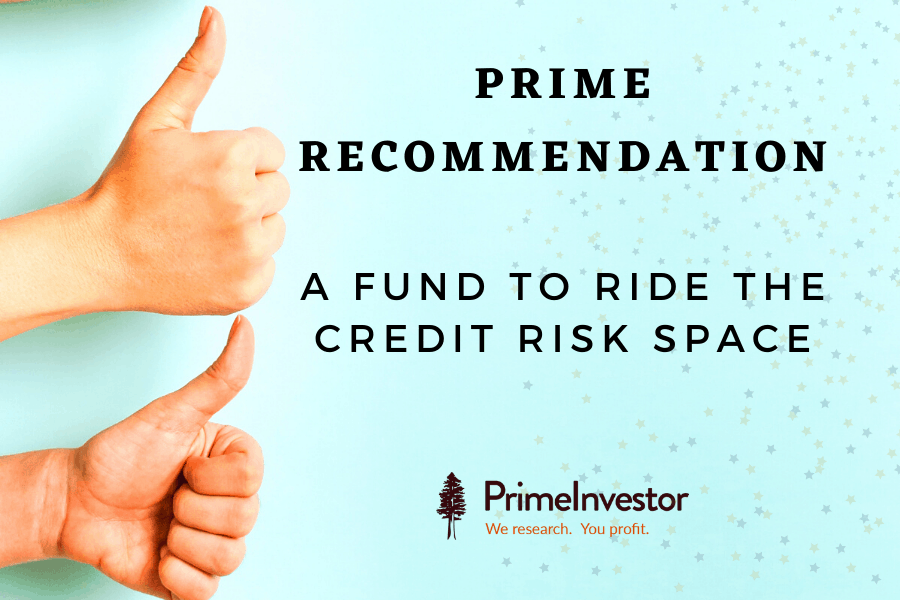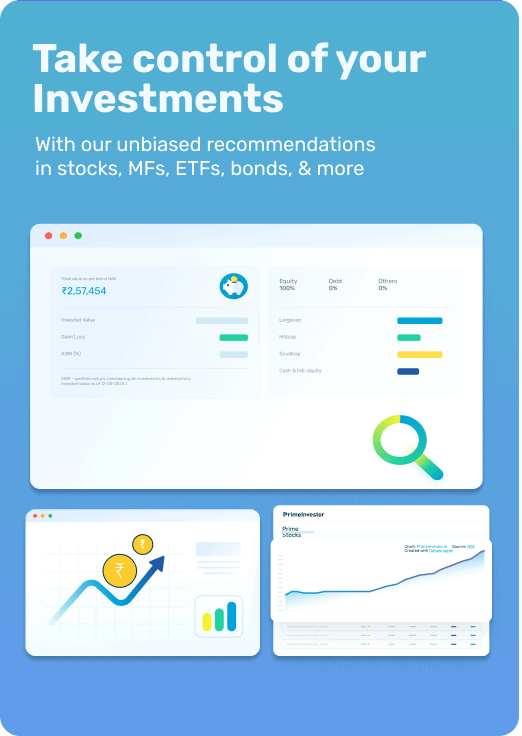The declining-to-flat interest rate for almost 3 years now has left many of you frustrated. If you had gone searching for greener pastures, chances are that you would have been hurt. For, this was also a period when credit risk assumed its worst form, beginning with the IL&FS saga in 2018 and at its peak in early 2020.
At PrimeInvestor, we did not add any debt fund in the credit risk space when we started out in 2020 (you might want to read our article on how we identify credit risk in debt funds). And even when a fund we recommended held partial credit risk, we made sure we classified them as high risk-long term. We did not pick any fund from the credit risk category as funds were busy segregating their bad assets.

Why credit now
We have now decided to give very selective calls in this space. The reasons for entering it now are as follows:
- One, the credit hits in the past 2 years and the regulatory changes post that have taken funds through a learning curve in terms of both credit and liquidity management. Fund portfolios are more structured with provision for liquidity than they were 2-3 years ago. Please note that we are not suggesting that the risk of default by companies has come down. We are merely stating that fund houses appear to be better equipped to deal with or curtail these risks than they were earlier.
- Two, that the RBI has chosen to hold rates steady despite climbing inflation means that it is more concerned about growth in this pandemic-ridden phase. That means high-quality investment options with high returns may not come by anytime soon. You may have to dig a little deeper to get returns.
- Three, if a growth trigger (as already seen in pockets) does happen, then the risk perception in the market can further reduce, lending capital appreciation opportunities in the credit space, as instruments get re-rated (upgraded).
The market already appears to be taking cognizance of this. The spread (difference between a bond and govt. security with similar tenure) in the AA-rated space for 1 and 3 years has shrunk between 87-97 basis points between December 2020 and now. This has meant that the risk perception has marginally reduced and we need not totally shun this space. This apart, despite the reduced differential, the spread is still over 200 basis points in the 1-3 years space. This provides adequate return for assuming measured risk.
Finally, instead of trying to play credit in other categories of funds, where the risk may appear masked for you as a retail investor (and therefore may slip your attention), it is more transparent for us to recommend it in a space that is clearly labelled as having ‘credit risk’. This way, your expectation and risk perception are set clear.
Suitability
Before we go on to the fund, if you identify with any of the following, we recommend you avoid the credit space for now - a limited corpus, a high dependency on your corpus for regular income and those with low-risk appetite. In all these cases, it’s best to stick to safe options. In the Indian context, it is not only a credit event that can trigger panic in the market. As seen with the Franklin India saga, a liquidity crisis can also hit the credit space quite brutally. In such events, if you park your income-generating corpus in these instruments, a repeat of the Franklin episode is well possible.
A credit risk fund can form part of your 5-year plus portfolio along with high quality debt funds. It should not be more than 10% of your debt fund allocation.
The fund & performance
ICICI Prudential Credit Risk fund is the scheme from the credit risk space that entered Prime Funds in our June 2021 quarter review. The credit events of the last few years have scarred the return track record of funds in this segment. Rolling 3-year returns from 2016 for the category averages at a poor 5.9% annualized return. Corporate bond funds did far better with an average 8.5% for the same period, aided by the duration rally as well.
However, ICICI Pru Credit Risk was one among the 2 credit risk funds (other being Kotak Credit Risk) that delivered over 9% average returns in this period. The Kotak fund, though, does not have a strong performance record like the ICICI fund. HDFC Credit Risk comes a close second but here again, both in terms of volatility and the worst return, ICICI does better as can be seen from data below.
Over a shorter period of 1 year too (returns rolled), ICICI Pru Credit Risk outperformed the category 100% of the time. Its risk-adjusted return (sharpe) was the highest in the category when 1-year returns were rolled daily for the last 3 years.
Portfolio
All the above does not make ICICI Pru Credit Risk a low-risk option. But it suggests that the fund has thus far managed its credit risk well. The fund’s average holding in instruments below AA+ rating was at 54% as of June 2021. This is a tad higher than the category average of 50% (ignoring 3 funds hit in earlier years with insignificant or no credit holding now).
The fund does hold some risky papers such as those from the Vedanta group (2.9%) or lower-rated ones like Adarsh Advisory Services (2.1%) and smaller/insignificant holdings in papers that carry higher credit risk. If you break the rating segment into those below AA rating, the fund held an average 20% in such instruments in the past 6 months. This is higher compared to the 14% for HDFC Credit Risk.
In other words, ICICI Pru Credit Risk does not have particularly lower risks than peers. What it has done is to deliver well for the higher risk taken.
ICICI Pru Credit Risk has some risk mitigation strategies that may help it overcome the risks from the marginally higher credit exposure it takes:
- One, it has lower concentration to its top-held papers. For example, its average exposure to the top 5 instruments (outside of govt. bonds) for the past 6 months stood at 13.5% as opposed to 18% for HDFC Credit Risk.
- Two, exposure to individual papers is curtailed. The highest holdings are presently under 4% of the portfolio with the top papers coming from Tata Motors Finance or Great Eastern Shipping Company (AA+) – which either have a good parent backing or sound rating.
- Three, well over a fourth of its portfolio is reasonably liquid, consisting of treasury bills, CPs, traded REIT/InvITs and government bonds. This can avert any sudden redemption/liquidity pressure.
- Four, the average maturity of its papers is 2.79 years (slightly lower than 3.06 years for HDFC and 3.67 years for Kotak) thus reducing longer exposure to high-risk papers.
ICICI Pru Credit Risk is managed by Manish Banthia and Akhil Kakkar. After losing assets (but to a smaller extent than the category) post March 2020, the fund has now seen addition to its AUM, which currently stands at Rs 7626 crore.
Please be reminded that credit risk funds are for those with deep pockets, long timeframes, and willing to take risk of capital loss.







19 thoughts on “Prime Recommendation: A fund to ride the credit risk space”
Hi I am an investor in this fund based on PI recommendation. Just now have received an email stating “We are proposing to make a change in fundamental attributes of the Scheme(s) and as an investor in the Scheme(s), we would like to inform you about the change for enabling you to take an informed decision. The change will be effective from closure of business hours on October 08, 2021 (Effective Date). Kindly refer to the link provided below to know about the change:”
They have given exit option if we are not comfortable with the change.
Please review and advise, thank you
Hello Sir, if you mean this: https://www.icicipruamc.com/docs/default-source/default-document-library/addendum.pdf?sfvrsn=be1db965_0 – nothing changes in our recommendation. It is justa clause across several debt funds to segregate portfolios separately to deal with any adverse credit event in any instrument. thanks, Vidya
Thank you
Hello Mam, Due to some compulsions I cannot
Invest through direct mode. Does it makes sense
to invest in this fund through regular mode since
the expense ratio seems to be quite high.
You are right that credit risk funds expense ratio is high as th commission is high on these products. You can skip it as it will pull down returns. Vidya
Hello Vidya
Thanks for the great write up , makes sense to take some exposure to CR funds in the fixed income portfolio.
1. Just wanted to know if this fund has had any previous histroy of credit defaults or segregated portfolio. I know it may be difficult to pull out this info from history.
2. What is the company or group of companies concentration? Is it spread out across different group of comanies?
Thanks
It’s part of our job to check these before giving a call 🙂
1. weekly rollign returns suggest no unusual write offs in the past 5 years
2. Yes it is spread out. other than tata group at 5.7%. a few arund 3-4% and rest insignificant.
thanks
Vidya
I invested in ICICI CR fund in August last year when spreads were far higher. it was a value call neverthless it was risky. I think the spreads are now far lower ( though in range of 200 basis points) and back to what they have been prior to covid crisis.
Good to know it clicked, esp. if you have the risk appetite. Hard for us to give such calls for public at large though! thanks, Vidya
Understood, I didnt have a huge conviction as well 🙂 so only a smaller % of debt portfolio. Thanks for the article.
Excellent article ! Really like the story telling, Connecting the dots from the beginning to get the context to the user and explaining the rationale.
Thank you sir!
This point is raised by all the leading mutual funds as highlighted in the monthly fact sheets.
I switched to dark mode. But now now able to switch back to light mode. Buggy UI!
Sorry about that. There is indeed some bug. For now, dark mode is removed. Refresh and enter. you will see the light mode. Vidya
Thanks Vidya for this review. What about AT-1, Tier 2 bonds holding by this fund? Is it lesser compared to peers and does it pose additional risk?
Holding mostly in quality ones and total holding not significant. thanks, Vidya
Very late identified.good article.
Very late?????😀😀 regards, Vidya
Comments are closed.